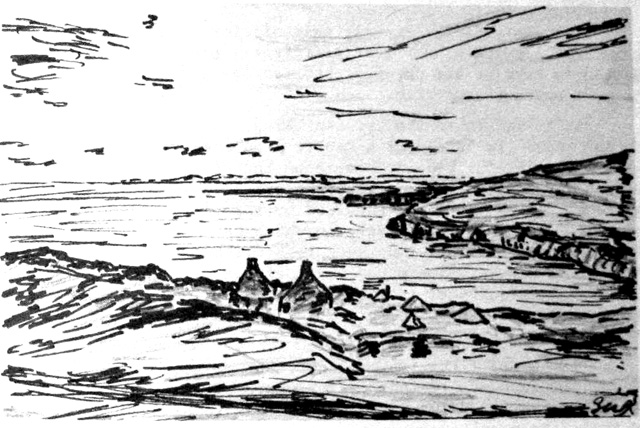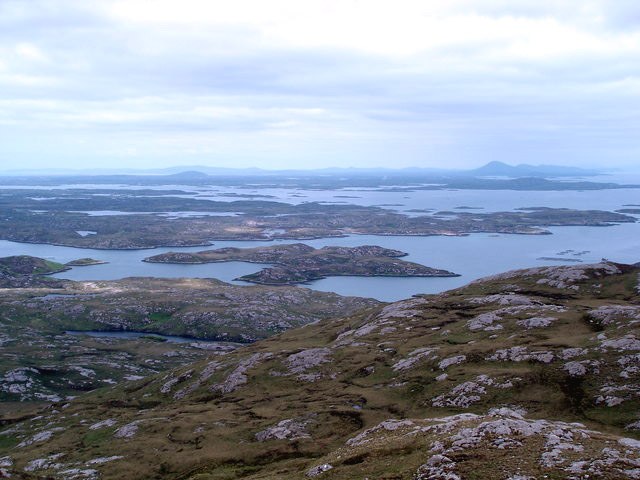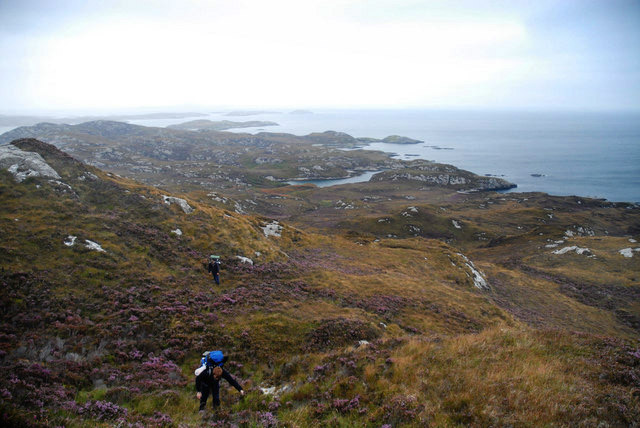![]()
![]()
South Uist 1970.
Leader: Geoff David
Stephen David, Alan Fowler,
Gavin Macpherson, Jenny Macpherson
Jonathon Orr, Alastair Philips.
LEADER'S REPORT
This was a hard, hard Expedition, full of peat and feet, sweat and toil, and tiny little bits of shapeless pottery that looked as though an angry Heffalump had stamped on them. But for all that we did what we cam to do - we proved that the Usinish Thing is a Man-Made Thing, we brought lots of juicy evidence back for the National Museum in Edinburgh to chew over, and we managed, really, to enjoy ourselves.
Part of the secret of our success was, of course, our Interior Economy. We had masses of food - almost more than was necessary to wipe out the memories of Starvation Camp, South Uist, 1969. Needless to say, this was purely due to miscalculation on my part: I had budgeted for twelve large and ravenous bodies, and by the time I had woken up to the fact that we were only going to be seven, it was too late to change the order.
But apart from that, the cooking and catering and the general camp comfort were of the highest order, thanks to the superb competence of the other members of the Expedition, notably Admiral Fowler, Baden Powell Orr, and Professor Philips; also Gavin our indomitable Surveyor, Jenny, our first Lady Officer, and Stephen of the Occasional Expletive. One of the nice things, in fact, about trying to 'lead' a very senior expedition like this is that one need not do anything at all except look wise and nod approval at intervals.
 The
camp-site helped, I think - within a few paces of a burbling stream which lulled
us to sleep every night, well-sheltered from gales, dry, within 200 yards of the
only trustworthy landing beach, and with a good view eastwards towards Skye and
our neighbours in the lighthouse.
The
camp-site helped, I think - within a few paces of a burbling stream which lulled
us to sleep every night, well-sheltered from gales, dry, within 200 yards of the
only trustworthy landing beach, and with a good view eastwards towards Skye and
our neighbours in the lighthouse.
Also, we were luxuriously well off for transport - three - cars in all, with a boat most efficiently provided by Mr Mac-Eachen to take us and our gear between the road end at Loch Skiport and our camp-site.
| The camp site at Mol a' Tuath. Artist not recorded (initials in bottom right?) |
But to return to the Usinish Thing. What was it? I still do not know. In last year's Report I gave my first impressions - a carefully-built hearth on top of a large pile of stones (or cairn') that might be natural (a lump of rock split by frost action and later engulfed by the slowly accumulating peat), or possibly artificial, in which case it was likely to be a chambered cairn dating back to Neolithic times - 3000 B.C. or even more. There was a lot of pottery mixed up with the hearth and some of it looked like Early Iron Age (say,500 B.C. to 500 A.D.), so this might be a site belonging to more than one period.
So much for first impressions. Our main job this year was try and find out if the 'cairn' was natural or artificial, this we tried two methods. One was to divide the 'cairn
’ up into four equal quadrants and then dig out one of the quadrants down to the stonework and the original ground surface on which it lay, in the hope of uncovering something like an entrance, or a burial chamber, or a carefully constructed outer kerb of large stones, all features of a chambered tomb.The other method, using Alistair Philips' Electronic Wizardry to take readings of the resistivity of the soil at regular distances all round the 'cairn', in the hope that anomalous readings caused by stonework hidden below the peat would show up some sort of significant shape.

Looking ~NNW from the top of Beinn na h-Aire, itself to the ~W of the camp site at Mol a' Tuath.
© Copyright Denis M Wilson |
While all this was going on, Alan Fowler would take samples of the peat at 5 cms. intervals from the present ground surface down to bedrock, and these, when analysed by the boffins in Macaulay Institute for Soil Research in Aberdeen, would show what types of vegetation were growing in the area at the time that each layer of peat was forming. As the experts already have a fairly good idea of what type of natural vegetation growing in Scotland during each of the slow stages between end of the last Ice Age and the present day, this was another way of deducing the approximate age of our 'cairn'.
So much for the plans. The actual work was not quite so beautifully simple. To be fair, the weather helped a lot. For most of the first week the wind blew and the skies were overcast and the air was cool, so that millions of little midges died of starvation or were borne shrieking in exasperation past our sweating bodies by the gale. Meanwhile, the work proceeded slowly and methodically, the Resistivity Surveyors maintaining their stately ritual dance along invisible lines, the rest of us hewing mightily at the everlasting peat which said "Shlurp" - in a heavy, determined way, every time our spade got near water, which was often - in fact, too often. In fact, the whole area was a gigantic sponge, carefully designed by prehistoric man, we decided, to satisfy his prehistoric sense of humour, and the peat would eventually kill us all and preserve us like Tollund Man in an inglorious nameless grave far from the bright lights of home.
However, we were over-pessimistic. Quite soon, we began finding pottery - little bits, but definitely pot, and definitely a different type from the stuff found in the hearth last year. Then Jenny found a RIM - a nice odd-shaped rim with a bit of crude decoration - probably fingertip impressions - on its lower part. By this time we were down to the old ground level, all the stonework had been exposed, and the lower part was surely artificial - it looked like a platform carefully and skilfully put together from angular blocks of stone and designed to take the heavy weight of a stone structure built on top of it, rather than form the roof of a burial chamber beneath. In any case, there was not room for a burial chamber beneath, as less than a foot below the level of the platform was the old ground surface, liberally sprinkled with very small bits of pottery.
 Could
these have been scattered with household refuse over the ground as a primitive
kind of manure on one-time fields? This was apparently the case at Gwithian, a
Bronze Age site in Cornwall, so why not here too? At any rate, this ancient
ground surface covered a clayey soil, definitely not peat, so it could have been
quite good arable land.
Could
these have been scattered with household refuse over the ground as a primitive
kind of manure on one-time fields? This was apparently the case at Gwithian, a
Bronze Age site in Cornwall, so why not here too? At any rate, this ancient
ground surface covered a clayey soil, definitely not peat, so it could have been
quite good arable land.
Meanwhile Alan had finished his peat sampling and was able to point out that the peat was in clearly distinct layers, some marking sphagnum (and therefore rather wet conditions) and others marking heather (and therefore a return to a drier climate). To get more peat samples in an area undisturbed by the 'cairn', he dug a control pit a short distance away - and deep in this peat came upon a piece of wood about a foot long, lying horizontally, with one end showing a straight edge as if cut by a sharp tool. Below this, he found the remains of what seemed to be a layer of brushwood, and below this again some large angular blocks of stone fitted closely together - seemingly the lowest stones of the 'cairn' on that side.
The wood is highly significant, as no trees grow in that area now - it is too exposed and the peat is inimical to tree growth. In due course we shall know what type of tree this was, as the wood fragment is now in the National Museum in Edinburgh being analysed.
Not content with that, Alan then dug another control pit slightly further from the 'cairn'. This pit went down through solid peat for over 2 metres, then through 30 cms. of earth, the top 10 cms. of it black with streaks of charcoal and the rest grey clay like the old ground surface found below the stones of the 'cairn'. The very great depth of peat above this charcoal layer suggests that the latter is prehistoric in origin - could this be more of the cairn-builders' primitive manuring?
| Near Uisinish Bay - slogging through the trackless heather! © Copyright Steve B |
Meanwhile, in the evenings, Alan and Alistair had been plotting on graph paper the results of the resistivity survey. The final effect was most impressive - a definite zone of high readings around the stonework that we had uncovered and extending over the whole of the area where we believed the 'cairn' to be. This suggests that there is a great deal more of the structure yet to be uncovered.
What we had uncovered was skilfully surveyed by Gavin (ably assisted by the Surveyor's Mate, Jenny) using a variety of instruments ranging from an Artillery Director borrowed from the splendidly co-operative Army Stores Officer in Benbecula to a levelling staff concocted out of driftwood and coloured, paper. Heath Robinson would have been proud of them.
Finally, on the last day, when all the measurements had been done, all the photographs taken, and most of the peat thrown back in, we decided to open up the rest of the hearth that we had uncovered last year. We did this partly for completeness and partly to amuse Philip Renold and his party who had come over from North Uist to visit us. We soon uncovered the pottery that we had left in place last year, and to our delight, found that it included two large pieces of rim, both decorated with parallel lines of thumb impressions. This was splendid, as the style of decoration is a great help in dating prehistoric pottery, and we got most of it out in one large piece mixed up with the clay and ash from the hearth, which should please the experts in the National Museum.
Unfortunately, the pottery was so fragile that getting it back to camp was a problem. In the end we bound the whole lump together with a crepê bandage, laid the resultant cocoon carefully to rest in a herring box brought up from the beach, padded it round with sphagnum moss, and then lugged the box -by now unbelievably heavy - the mile-and-a-half over the moor, taking it in turns to carry it between us. A monumental effort, and a fitting climax to ten days of very hard work.
And that was the end of the dig. The next day we were smoothly evacuated from our campsite by the ever-efficient Mr MacEachen and his cousin in their lobster boat (overloaded like a Noah's Ark, but the sea was flat calm), and the following two days we 'swanned' unashamedly, spending one unforgettable afternoon on one of the huge west coast beaches, slightly crowded because there was another party of two people visible about a mile away; we also investigated the southern tip of the island and found an idyllic camp-site looking south to Eriskay - definitely a 'must' for next time.
We owe a lot of thanks to a number of people. To Mr McIntyre, the factor of the Daliburgh Estates, for kindly advice on a number of points; to Mr MacEachen and his cousin for their excellent boat transport; to the Keeper of the Usinish Lighthouse, and his assistants, for their friendly help and forbearance on several occasions; to the Army at Benbecula Camp for their help over surveying equipment; to Philip Renold and his friends for much appreciated luxury accommodation in North Uist on two occasions; and perhaps most of all to John Hutchinson for organising our food supplies so thoroughly and well. .. Seldom has an expedition marched so faultlessly on its stomach!
-GEOFF DAVID